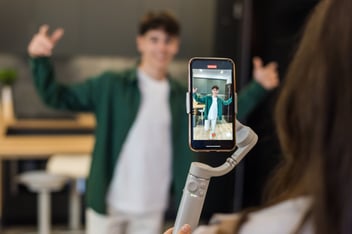Hardwired To Binge: Here's Why Everyone's So Obsessed With Video
Let’s face it: We are either too lazy to read an article, or we just prefer video because it’s easier to digest.
In fact, you’d probably enjoy this blog a lot more if there was a video or at least some graphic involved, which is why we included fun GIFs!
According to KPCB, online video accounts for 74 percent of all online traffic. Cisco predicts that this number will increase to 82 percent by the year 2020, which makes sense considering the growing number of individuals who have access to the internet worldwide.
That said, this raises another question: Why are we so fascinated with video?
Well, our brains have the answers.
The human brain seeks the easiest solution.
The reason the vast majority of online traffic is video driven is very simple: Our brains prefer video. According to Zabisco, we respond far better to visual information compared to plain text. Ninety percent of information transmitted to the brain is visual.
In other words, we consume more videos because they are easier and quicker to process than text.
All of us, as human beings, are wired to thrive and survive and preserve calories. Therefore, we seek the clearest message — something simple and that we can understand instantaneously.
In the words of author and StoryBrand founder Donald Miller, "Consumers don’t buy the best product or service, but rather the product that is easier to understand.”
Video offers you just that: a simple idea to understand in a couple of seconds.
We are wired to avoid distractions.
John Medina’s Brain Rules further examines our brains’ fascination with visuals. He determined we don’t pay attention to boring things because our brains are not capable of multitasking.
The human brain is designed to survive and focus on essentials. Therefore, our brains immediately block unnecessary information when performing more than one activity. This explains why we drift off during conversations that are not interesting to us. You know, like when your uncle goes on and on about his coin collection.
Video allows our brain to concentrate on only one activity: Consume information.
Our brain retains more information when we use more senses.
Video is also the easiest form of media to consume because it forces our brain to use more than one sense. On average, we remember 10 percent of anything we learn. Yet, if we add a visual stimulation, we will remember 65 percent of the same concept.
Even better, if we are exposed to visual and sound stimulation, it is very likely we will remember up to 87 percent of the concept, according to Brain Rules.
In other words, our brain remembers when we reduce distractions and enable multiple senses.
The brain seeks guidance.
The most important reason our brain is driven toward visual stimulation is empathy. Our brain seeks guidance for answers, but we must do something emotionally relevant to keep our attention.
Empathy can be delivered through video while touching on emotions. Therefore, video is the most effective form of media to deliver a message that stays with consumers.
Thank you for reading! Comment below if you want to give me feedback or ideas on what to write next!






